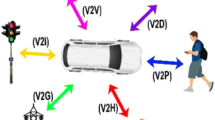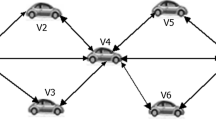Abstract
Vehicular ad hoc networks are a vibrant technology for future intelligent transport system. Vehicular ad hoc networks are a sub-level of wireless sensor network which establishes vehicle connectivity through wireless medium. Once the vehicles communicated with each other, vehicle mobility with a dynamic network environment faces new challenges. The intelligent transport system continues to evolve high packet delivery rate which is required to enhance the security application thus reduces the packet latency. This paper proposes a hybrid routing protocol called cache agent based location aided routing using distance and direction (CALAR-DD). The proposed protocol is a fusion of geocasting and position-based routing with distance and direction. The CALAR-DD operates in two steps. First, it chooses the next hop vehicle to forward the packet until it reaches the expected region. The expected zone becomes geocast region at the second step. Within this region, cache agent-based geocasting is used to find and forward the packets to the destination. The simulated outcome explores the improved performance of the proposed protocol over ID-LAR, M-GEDIR and FL-DGR in terms of packet delivery ratio, average delay, hop count and retransmission ratio.











Similar content being viewed by others
References
Chlamtac, I., Conti, M., & Liu, J. J. N. (2003). Mobile ad hoc networking: imperatives and challenges. Ad Hoc Networks,1, 13–64. https://doi.org/10.1016/S1570-8705(03)00013-1.
Kasana, R., & Kumar, S. (2018). Reliable geographic routing protocol for vehicular ad-hoc networks under shadowing and multipath environments. In International conference on information and communications technology (ICOIACT), Yogyakarta (pp. 180–185). https://doi.org/10.1109/icoiact.2018.8350734.
Nebbou, T., Fouchal, H., Lehsaini, M., & Ayaida, M. (2017). A realistic location service for VANETs. In G. Eichler, C. Erfurth, & G. Fahrnberger (Eds.), Innovations for community services. I4CS 2017. Communications in computer and information science (Vol. 717). Cham: Springer. https://doi.org/10.1007/978-3-319-60447-3_14.
Abbasi, I., & Shahid Khan, A. (2018). A review of vehicle to vehicle communication protocols for VANETs in the urban environment. Future Internet,10, 14. https://doi.org/10.3390/fi10020014.
Smiri, S., Boushaba, A., Ben Abbou, R., & Zahi, A. (2018). Geographic and topology-based routing protocols in vehicular ad-hoc networks: Performance evaluation and QoS analysis. In 2018 International conference on intelligent systems and computer vision (ISCV), Fez (pp. 1–8). https://doi.org/10.1109/isacv.2018.8354070.
Ashtaiwi, A., & Saoud, A. (2017). Performance comparison of position-based routing protocols for VANETs. In International conference on internet of things, embedded systems and communications (IINTEC), Gafsa (pp. 78–84). https://doi.org/10.1109/iintec.2017.8325917.
Liu, J., Wan, J., & Wang, Q. (2016). A survey on position-based routing for vehicular ad hoc networks. Telecommunication Systems,62, 15. https://doi.org/10.1007/s11235-015-9979-7.
Sataraddi, M. J., Kakkasageri, M. S., Kori, G. S., & Patil, R. V. (2017). Intelligent routing for hybrid communication in VANETs. In IEEE 7th international advance computing conference (IACC), Hyderabad (pp. 385–390). https://doi.org/10.1109/iacc.2017.0087.
Gurumoorthi, E., & Ayyasamy, A. (2017). A comprehensive study for geocast routing and its tool on VANET. International Journal of Pure and Applied Mathematics,117(15), 1177–1184.
Silva, A., Niaz Reza, K. M. & Oliveira, A. (2018). An adaptive GPSR routing protocol for VANETs. In 15th International symposium on wireless communication systems (ISWCS), Lisbon (pp. 1–6). https://doi.org/10.1109/iswcs.2018.8491075.
Jomaa, D., Yella, S., & Dougherty, M. (2017). A comparative study between vehicle activated signs and speed indicator devices. Transportation Research Procedia,22, 115–123.
Abbasi, I. A., & Shahid Khan, A. (2018). A review of vehicle to vehicle communication protocols for VANETs in the urban environment. Future Internet,10, 14.
Demba, A., & Möller, D. P. F. (2018) Vehicle-to-vehicle communication technology. In Proceedings of the 2018 IEEE international conference on electro/information technology (EIT), Rochester, MI, May 3–5, 2018 (pp. 459–464).
Tahmasbi-Sarvestani, A., Mahjoub, H. N., Fallah, Y. P., Moradi-Pari, E., & Abuchaar, O. (2017). Implementation and evaluation of a cooperative vehicle-to-pedestrian safety application. IEEE Intelligent Transportation Systems Magazine,9, 62–75.
Endo, M., & Tanaka, K. (2018) Evaluation of storage capacity of electric vehicles for vehicle to grid considering driver’s perspective. In Proceedings of the 2018 IEEE international conference on environment and electrical engineering and 2018 IEEE industrial and commercial power systems Europe (EEEIC/I CPS Europe), Palermo, June 12–15, 2018 (pp. 1–5).
Silva, C. M., Silva, L. D., Santos, L. A. L., Sarubbi, J. F. M., & Pitsillides, A. (2018). Broadening understanding on managing the communication infrastructure in vehicular networks: Customizing the coverage using the delta network. Future Internet,11, 1.
Noh, S., An, K., & Han, W. (2015). Toward highly automated driving by vehicle-to-infrastructure communications. In Proceedings of the 2015 15th international conference on control, automation and systems (ICCAS), Busan, October 13–16, 2015 (pp. 2016–2021).
Corchero, C., & Sanmarti, M. (2018) Vehicle-to-everything (V2X): Benefits and barriers. In Proceedings of the 2018 15th international conference on the European energy market (EEM), Lodz, June 27–29, 2018 (pp. 1–4).
Bian, K., Zhang, G., & Song, L. (2018). Toward secure crowd sensing in vehicle-to-everything networks. IEEE Network,32, 126–131.
IoT automotive—what vehicle to everything (V2X) is, part—3 of 3. Retrieved May 15, 2019, from http://www.infiniteinformationtechnology.com/what-vehicle-to-everything-v2x-is-part-3-of-3.
Vehicle-to-everything (V2X) technology will be a literal life saver—But what is it?. Retrieved May 15, 2019, from http://eecatalog.com/chipdesign/2016/05/19/vehicle-to-everything-v2x-technology-will-be-a-literal-life-saver-but-what-is-it/.
Liu, L., Chen, C., Ren Z., & Shi, C. (2017). A link transmission-quality based geographic routing in Urban VANETs. In IEEE 28th annual international symposium on personal, indoor, and mobile radio communications (PIMRC), Montreal, QC (pp. 1–6). https://doi.org/10.1109/pimrc.2017.8292286.
Lu, T., Chang, S., & Li, W. (2018). Fog computing enabling geographic routing for urban area vehicular network. Peer-to-Peer Networking and Applications,11, 749. https://doi.org/10.1007/s12083-017-0560-x.
Rana, K., Tripathi, S., & Raw, R. S. (2018). Analytical analysis of improved directional location added routing protocol for VANETS. Wireless Personal Communications,98, 2403. https://doi.org/10.1007/s11277-017-4980-y.
Cruz, S. B., Abrudan, T. E., Xiao, Z., Trigoni, N., & Barros, J. (2017). Neighbor-aided localization in vehicular networks. IEEE Transactions on Intelligent Transportation Systems,18(10), 2693–2702. https://doi.org/10.1109/TITS.2017.2655146.
Asoudeh, S., Mehrjoo, M., Balouchzahi, N. M., & Bejarzahi, Abdolvahed. (2017). Location service implementation in vehicular networks by nodes clustering in urban environments. Vehicular Communications,9, 109–114. https://doi.org/10.1016/j.vehcom.2017.04.002.
Abbasi, I. A., Khan, A. S., & Ali, S. (2018). A reliable path selection and packet forwarding routing protocol for vehicular ad hoc networks. EURASIP Journal on Wireless Communications and Networking. https://doi.org/10.1186/s13638-018-1233-z.
Mantas, N., Louta, M., Katsaros, K., & Kraounakis, S. (2017). Social CLWPR: A socially enhanced position-based routing protocol for handling misbehaviour inVANETs. In 8th International conference on information, intelligence, systems & applications (IISA), Larnaca (pp. 1–6). https://doi.org/10.1109/iisa.2017.8316449.
Jaiswal, R. K., & Jaidhar C. D. (2017). PPRP: Predicted position based routing protocol using kalman filter for vehicular ad-hoc network. In Proceedings of the 18th international conference on distributed computing and networking (ICDCN ‘17). New York: ACM. https://doi.org/10.1145/3007748.3007762.
Jamali, M. A. J., & Rahimi, S. (2018). A hybrid geographic-DTN routing protocol based on fuzzy logic in vehicular ad hoc networks. Peer-to-Peer Networking and Applications. https://doi.org/10.1007/s12083-018-0642-4.
Hassan, A. N., Abdullah, A. H., Kaiwartya, O., Cao, Y., & Sheet, D. K. (2018). Multi-metric geographic routing for vehicular ad hoc networks. Wireless Networks,24(7), 2763–2779. https://doi.org/10.1007/s11276-017-1502-5.
Alzamzami, O., & Mahgoub, I. (2018). Fuzzy logic-based geographic routing for urban vehicular networks using link quality and achievable throughput estimations. IEEE Transactions on Intelligent Transportation Systems. https://doi.org/10.1109/TITS.2018.2867177.
Pandey, K., Raina, S. K., & Raw, R. S. (2016). Distance and direction-based location aided multi-hop routing protocol for vehicular ad-hoc networks. International Journal of Communication Networks and Distributed Systems,16(1), 71–98. https://doi.org/10.1504/IJCNDS.2016.073410.
Kaiwartya, O., & Kumar, S. (2015). Cache agent-based geocasting in VANETs. International Journal of Information and Communication Technology,7(6), 562–584.
Raw, R. S., Lobiyal, D. K., & Das, S. (2015). Analytical evaluation of directional-location aided routing protocol for VANETs. Wireless Personal Communications,82(3), 1877–1891.
Ko, Y. B., & Vaidya, N. H. (2000). Location-aided routing (LAR) in mobile ad hoc networks. Wireless Networks,6(4), 307–321.
Author information
Authors and Affiliations
Corresponding author
Additional information
Publisher's Note
Springer Nature remains neutral with regard to jurisdictional claims in published maps and institutional affiliations.
Rights and permissions
About this article
Cite this article
Gurumoorthi, E., Ayyasamy, A. Cache agent based location aided routing using distance and direction for performance enhancement in VANET. Telecommun Syst 73, 419–432 (2020). https://doi.org/10.1007/s11235-019-00617-0
Published:
Issue Date:
DOI: https://doi.org/10.1007/s11235-019-00617-0




